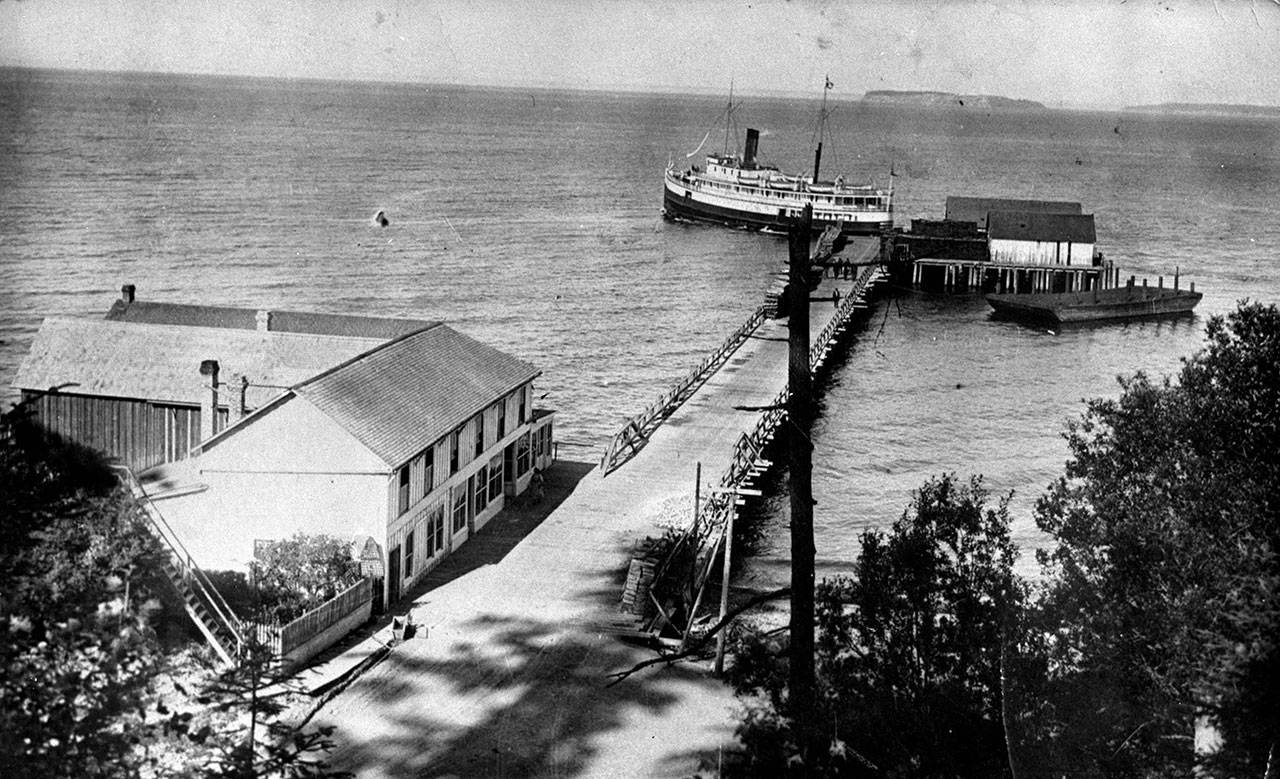My dad, Lloyd Pearson, a former ranger at Sequim Bay State Park (1960-1987), loved to take me to get a cup of coffee and go for a drive.
Dad’s primary love was dairy farms — he owned and ran one in Whatcom County before moving to Sequim in 1960 — so our random destination would typically be a dairy farm. Frequently we would head out to what was called Port Williams.
My dad passed away in 2013 and now I find myself taking these drives and picking a random spot. And since 2020 has been the year of drives, with one at times not being able to do anything else, I found myself back at Port Williams — or what’s now called Marlyn Wayne Nelson Memorial Park.
The Clallam County park is described today as a beach for families, birdwatchers, dog lovers and beach walkers. But as I drove down the road that ends at the park, I wondered how many people knew about Port Williams, and did they know there had been an active port there at one time?
How many people would remember Port Williams as a place of history, for not just Sequim but Clallam County? This wondering prompted me to investigate the history of Port Williams.
Sequim once had two ports of entry: New Dungeness and Port Williams. People coming into Port Williams by boat were taken to Sequim by horse and/or wagon combinations.
Merchandise was taken by the same mode of transportation. According to “Images of America, Sequim-Dungeness” by Katherine Vollenweider: “Port Williams was homesteaded in 1882 by Frank James, Robert Travers, and James Woodman. A Post Office and Western Union Telegraph Co was there. Ships arrived daily from Seattle en-route to Clallam Bay or Neah Bay.”
I found other information from “Jimmy Come Lately,” a history of Clallam County written by the Clallam County Historical Society, with a detailed description in a section written by Mrs. Gertrude B. Wilder for Port Williams:
“The town of Port Williams was named after Thomas Williams, a contractor.
Robert Travers, who was a light keeper at Tatoosh Island in 1858, homesteaded and patented the place which Mrs. James R. Gates now owns. The land patent to Robert Travers for his homestead was dated January 20, 1882.
Travers platted the townsite of Port Williams. Eight acres for a Travers Reserve were set aside, seven hundred twenty-four feet by four hundred eight-one and one-third feet, between Shannon and Shephard Ave in 1890.
Portions of the plat were cancelled by the Board of County Commissioners in December 1890. John Wilder built a brick yard at Port Williams after moving there from Port Townsend about 1891.
He operated the brickyard for eight months at Port Williams. Hans Bugge bought Port Williams in 1891. It was the only access to Sequim at the time. The dock was built about 1890. C.C. Bowman built the hotel and restaurant. The telegraph office and post office were also located in the main buildings at Port Williams. November 19, 1860.
It was discontinued September 3, 1861. It was reestablished April 11, 1890 to be discontinued again January 15, 1919.
There was a bridge built across the lagoon between Port Williams and Washington Harbor. The dance hall was above the general store. Mail, freight and passengers were brought in by boats of the Puget Sound Navigation Company from Settle, Port Angeles and other ports upsound.
When C.J. Erickson built the Chicago, Milwaukee Railroad through the Dungeness Valley in 1914, the telegraph office was discontinued at Port Williams.
The townsite was abandoned in 1922. What was once a busy port of entry for Sequim is totally gone now and is part of history. The county has established the area as Marlyn Wayne Nelson Memorial Park at the old wharf site of Port Williams and a boat launch ramp for fisherman.”
So, we now have a timeline and a baseline for Port Williams. One needs to mention Hans J. Buggee who bought Port Williams and who had established a cannery at Washington Harbor.
Bugge was born 1862 in Norway and died Jan. 23, 1923. He is listed as a Dungeness Valley Pioneer 1891 in Washington Harbor.
Port Williams, now named Marlyn Wayne Nelson Memorial Park, was deeded to Clallam County Parks in 1976. Marlyn Wayne Nelson was a victim of the Pearl Harbor attack on Dec. 7, 1941. He was aboard the U.S.S. California which was hit by torpedoes. He died from his injuries Dec. 11, 1941, in Honolulu, Hawaii.
The memorial was dedicated on Nov. 11, 1944 by C. W. Mays, who was a Pearl Harbor survivor aboard the U.S.S Nevada.
Pictures of Marlyn Wayne Nelson can be found at www.findagrave.com/memorial/15479403/marlyn-wayne-nelson, and there is an article in the Sequim Gazette dated Dec. 7, 2006.
Information for this park and other county parks is www.clallam.net/parks.
Next time you find yourself in the area once referred to as Port Williams, remember the value of this major link as an important port for Sequim and Clallam County.
Laurie Davies (Pearson) has lived in Sequim most of her life. Growing up at Sequim Bay State Park, attending Sequim schools and living in Sequim, she has given appreciation for the area and county. The information mentioned above is from authoritative history and the intent was to convey information regarding Clallam County history.


